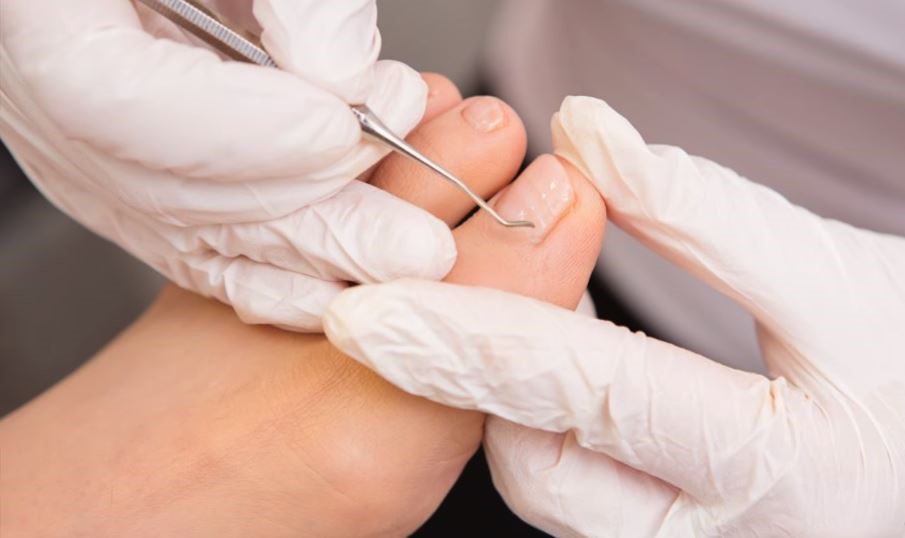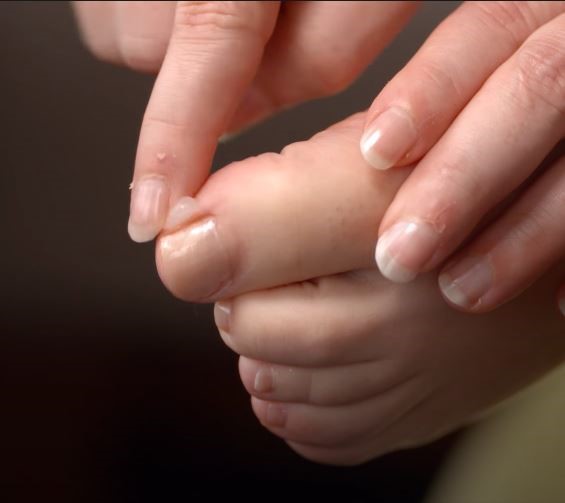How to Get Rid of an Infected Toenail at Home
Ingrown toenails that are not showing signs of infection can be treated at home. There are ingrown toenail remedies for mild cases that only need simple treatment.
Health care professionals do not recommend treating an infected ingrown toenail. Never attempt to lift your ingrown toenail with cotton or dental floss. This could only introduce bacteria into the affected area.

You should see your foot and ankle doctor (podiatrist) if:
- home remedies do not work for you
- you have poor circulation (poor blood flow) or
- you have diabetes
Ingrown toenail treatment for serious cases done by a foot and ankle podiatric surgeon include:
- lifting the nail
- partially removing the nail and
- removing the nail and tissue
Safe and Effective Ingrown Toenail Home Remedies
1. Warm, Soapy Water Soak

Soaking your affected foot in warm, soapy water may help ease pain and reduce swelling. You should do this 3 times daily for up to 20 minutes. Adding a small amount of liquid Castile soap may bring extra relief.
Be sure to dry your foot rigorously after soaking.
2. Apple Cider Vinegar Soak
Apple cider vinegar is considered a folk remedy for a majority of ailments these days. And this includes ingrown nails. Apple cider vinegar is known to have anti-inflammatory, antiseptic and pain-relieving properties.
However, scientific evidence for apple cider vinegar as a remedy to common ailments is limited at best.
You can try to treat an ingrown nail by soaking your affected foot in a bucket or basin of warm water mixed with a ¼ cup of apple cider vinegar. Do this for up to 20 minutes daily.
Remember to always dry your foot thoroughly once you are done with the soaking.
3. Epsom Salt Soak
Epsom salts contain high amounts of magnesium which is known to fight inflammation according to a study. Such a soak provides relief from the swelling and pain of your affected foot.
In a wide bucket or basin, add 1 to 2 tablespoons of Epsom salt per quart of warm water. Soak your foot and gently massage the affected skin area downward. Do this 2 to 3 times every day for 15 to 20 minutes.
4. Hydrogen Peroxide Soak
Hydrogen peroxide is another great option to treat ingrown toenails at home. It is a natural disinfectant, which is the reason why it is commonly used to clean wounds.
Soak your infected foot in a bucket of water and hydrogen peroxide solution for 15 to 20 minutes. Do this 2 to 3 times daily. Make sure to add at least 3% of hydrogen peroxide for every half cup of warm water.
5. Wearing Comfortable Footwear

Overcrowding your toes by wearing ill-fitting shoes is one of the leading causes of ingrown toenails. You can prevent an ingrown from developing in your big toe by wearing comfortable shoes.
Be sure to pick better-fitting shoes that have enough space for your toes. Comfortable footwear should allow you to wiggle your toes.
During the healing process, wear sandals instead of shoes to prevent pressure on your inflamed toenails.
6. Using Toe Protectors
You should consider wearing toe protectors if your day-to-day activities require you to wear shoes all the time.
Toe protectors provide a soft, protective barrier between your toes and your shoes. They are usually stretch-to-fit caps made from elastic materials.
7. Taking Oral Antibiotics
Doctors do not usually prescribe oral antibiotics for mild cases of ingrown toenails. There has been no proof that oral antibiotics can improve the condition.
Still, you may need oral antibiotics if you have a weakened immune system. Also, if your ingrown nail shows signs of infection such as:
- foul odour
- presence of pus
- throbbing pain
- increased redness
- increased swelling
- warmth in and around the affected toe
Common antibiotics used to treat an ingrown toenail are:
- Amoxicillin
- Flucloxacillin
- Cephalexin
- Erythromycin
8. Taking OTC Pain Relievers
To counter pain caused by an ingrown nail, you can take an over-the-counter pain reliever. One example is Panadol, which is paracetamol. Be sure to take only the recommended daily amount of 3,000 milligrams to avoid side effects.
Nurofen is ibuprofen and is a better solution if there is pain and swelling. Common side effects of ibuprofen include:
- diarrhoea
- upset stomach and
- abdominal pain
Voltaren is diclofenac and it can also help ease the pain in your toes. Both of these drugs are called non-steroidal anti-inflammatory medications and all of them can cause stomach and bowel upset.
9. Applying Antibiotic Ointments

Applying an antibiotic ointment or cream is one of those ingrown toenail remedies that help reduce the risk of infection. It can also promote healing of your infected toe. Make sure to follow the manufacturer's instructions and bandage your toe after applying the ointment.
Antibiotic ointments you can use to treat ingrown toenails include:
- Bactroban
- Tricin
Visit Your Foot and Ankle Doctor If Ingrown Nail Home Remedies Do Not Work
Do not ignore an ingrown nail if it is already showing signs of infection. Not taking immediate action could lead to serious complications.
Take action NOW! Contact Adelaide Foot and Ankle for an appointment.
How to Get Rid of an Infected Toenail at Home
Source: https://adelaidefootandankle.com.au/9-ingrown-toenail-remedies/